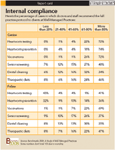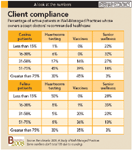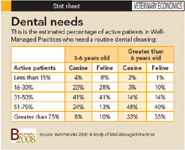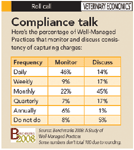Got a "C" in compliance?
If your client and internal compliance is just average-or worse-jump to the head of the class with these tips.
Back when you were in veterinary school, would a 50 percent have cut it? No way! That's a big fat "F"! What about a 75 percent? Better. But there's definitely room for improvement. Consider this: AAHA conducted a landmark study in 2002 that revealed significant compliance gaps in what doctors believe is the best wellness care and treatment for pets. The study examined six key areas: heartworm testing and prevention, dental cleanings, therapeutic diets, senior screenings, core vaccines, and preanesthetic testing. Results showed that when a veterinarian guessed that compliance was at about 75 percent in his or her practice, it was actually closer to 50 percent.

Photo: Mark McDonald
As an educated, experienced veterinarian, you know what's best for your patients. Clients place their trust in you when it comes to their pets' health and, ideally, they follow your recommendations. But the reality is that too often clients don't comply. Why not?

Denise Tumblin, CPA
Sometimes they don't follow through because the rest of the veterinary team failed to reinforce your recommendation. If the client hears one message from you, a different message from your technician, and a third message from another team member, that client becomes thoroughly confused. Sometimes the client doesn't comply because of information overload. That person got too much information and too many options to decide between. Without a clear, simple directive from you, the easiest thing for a client to do is nothing at all.

The bottom line
Compliance 101
Before we really dig into the subject of compliance and how to fill the gaps, let's look more closely at why these gaps exist in the first place. In Benchmarks 2008: A Study of Well-Managed Practices, we set out to tackle this tricky subject. And the results of our study reveal that there are still areas for growth. Part of the problem is that despite established medical standards of care, internal compliance among doctors and team members following the standards is woefully low in some areas (see "Internal Compliance" below for more). For example, 94 percent of study participants say all of the doctors in their practices share a consistent philosophy regarding vaccination frequency. Yet internal compliance with the standard is low—28 percent of practices reported less than 80 percent compliance with their own canine vaccination standard, and 31 percent reported less than 80 percent compliance with their feline standard. If all the doctors agree, why are they so inconsistent—and does it even matter?

Internal compliance
Of course, part of the standards of a hospital would be for the doctor to decide, patient by patient, when it's appropriate to go outside the standard recommendation. But many inconsistencies occur because the practice doesn't have a well-established method of communicating its standards of care to doctors and staff. Or the doctors may not discuss standards of care on a regular basis. Therefore everyone assumes the doctors are practicing similarly—when they're not even close. These differences may lead to shortcomings in patient healthcare and confusion among the doctors, team members, and clients. They also create the potential for disagreements that can sour practice relationships.

What is a Well-Managed Practice?
Well-defined, robust medical standards can shape practice culture, improve relationships among co-workers and clients, and grow the business side of the practice. They're critically important to your success. But before you develop your medical standards, you must first identify your target client.
Putting pencil to paper
Let's brainstorm a bit. Who is your ideal client? Is your goal to serve pet owners who seek only the best for their pets—and can afford it? Are you aiming at clients who want excellence in pet healthcare and client service but for whom cost is sometimes an obstacle? Or are you attracting clients who just want low-cost care? Be clear about who you want to serve and build your standards on that foundation. Trying to be all things to all people confuses everyone and leads to low compliance all around.

Client compliance
Once you've defined your target client, develop written standards of care that identify the baseline healthcare components for each type of medical case. Ask your entire team to help decide what these components will be. And use your standards as an ongoing teaching tool to bolster consistency, continuity, and compliance within your practice.
Being proactive is an important step on the road to "A+" compliance. Take responsibility for ensuring that your patients receive the care they need. Review the medical record each time you handle it to see whether the patient is missing any necessary component of your healthcare standards. And be sure to ask every potential client who calls the practice whether he or she would like to schedule an appointment. Don't wait for clients to ask, because they might not.

Dental needs
At the end of each visit, schedule the pet's next appointment for additional necessary care. If the client isn't able to schedule at that time, call within a day or two to get the appointment in the book. See "A 13 Step Program for Increasing Compliance" on page 38 for more.
Extra credit: dentistry
Now, let's take a closer look at dentistry. Benchmarks 2008 study results show that there are significant opportunities for improving client compliance with dentistry recommendations. Well-Managed Practices average about 1,900 active patients per doctor. Of those active patients, 26 percent are 3 to 6 years of age and 45 percent are older than 6. Study participants estimated that many of their patients who fall into these age ranges need a routine dental cleaning. See "Dental Needs" below for more.

Compliance talk
If 50 percent of the 3- to 6-year-old patients and 75 percent of the greater-than-6-year-old patients had their teeth cleaned, it would result in about 890 cleaning procedures per full-time-equivalent doctor per year. The average number of dental cleanings completed in 2007 was 114 per doctor. If the cost for a routine procedure averaged $350, you could generate about $270,000 more per doctor. Now that's good for the patient and your bottom line.
Be the class valedictorian: Capture all charges
It's easy to miss a charge here and there. But those $34 medical progress exams and $22 fecal exams add up. And over time that total could be costing your practice a coveted piece of equipment or the extra hands needed to smooth out a busy day. Creating awareness within the practice is the first step to reducing the frequency of missed charges.
With all the talk about recession, many business owners are understandably nervous about the economic climate. The concern about a recession is real, but the good news is that many veterinary practices have tremendous potential for continued growth by enhancing compliance with their existing patients' healthcare needs. Use Benchmarks 2008: A Study of Well-Managed Practices to help you ace Compliance 101 and shoot straight to the head of the class. Enhanced compliance is good for the patient, good for the client relationship, and good for the bottom line. And it looks good on your report card.
Veterinary Economics Editorial Advisory Board member Denise Tumblin, CPA, is owner of Wutchiett Tumblin and Associates in Columbus, Ohio. Send comments to ve@advanstar.com or post your thoughts on our message boards at dvm360.com. Catch Tumblin in action at the Progress in Practice Seminars Oct. 29 to 30 in San Diego held in conjunction with CVC West.